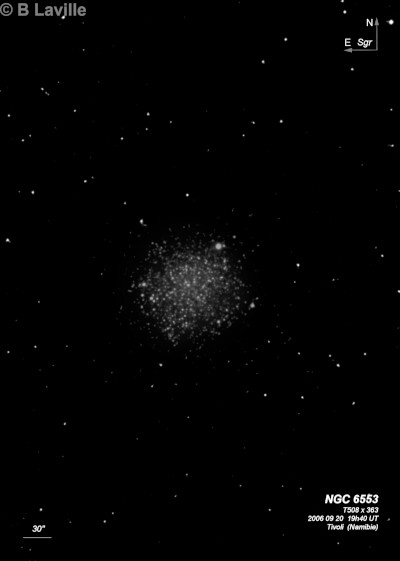
William Herschel discovered NGC 6553 = H IV-12 = h3730 on 22 May 1784 (sweep 223) and recorded "pB, L, difficulty resolving; the nebulosity inclining to milkiness. It is unequally bright." John Herschel called this cluster "globular; vF; a little oval; vglbM; barely r; stars 20m; one * 14m; diam in RA = 7.5 sec." Christian Peters independently found the cluster around 1849 at the Capodimonte Observatory in Naples and claimed it did not appear in any catalogue.
Pietro Baracchi observed the cluster on 5 Oct 1885 with the 48" Melbourne telescope and wrote "pB, pL, irr shape, gbM, a little elongated 150°, 90" long, 60" broad. Resolvable into extremely minute stars. A multitude of small stars in the field."
200/250mm - 8" (7/31/81): fairly bright, moderately large. A single star is at the north edge, elongated or fan-shaped N-S, no resolution.
400/500mm - 17.5" (6/6/86): grainy, mottled globular with a single bright star at the north edge and four or five additional stars at the edges may also be resolved members. Located in a rich field. The brightest member star is V = 14.7.
600/800mm - 24" (7/30/16): at 260x, moderately bright and large, ~3' diameter, weak concentration with no well defined core. A mag 11.8 star is on the northwest side of the halo and fainter stars are on the northeast side (pair) and southwest side, bounding the cluster into a somewhat rectangular appearance. At 432x, the cluster was very lively or mottled with a couple of additional resolved stars and others just on the verge of resolution. A few additional stars were resolved around the edges of the halo.
Notes by Steve Gottlieb